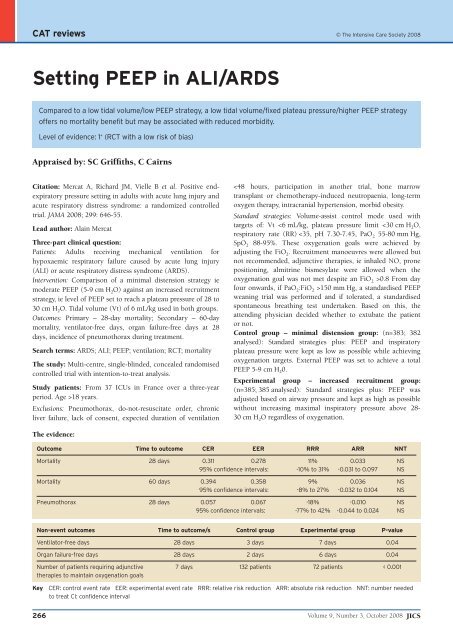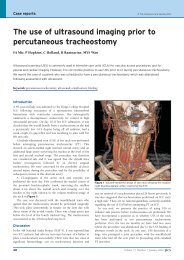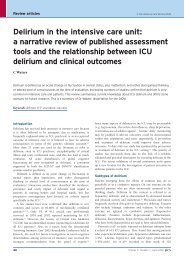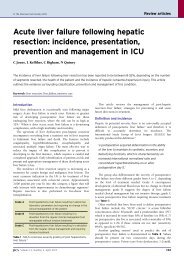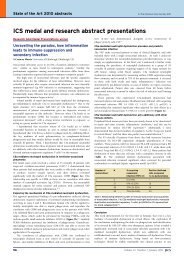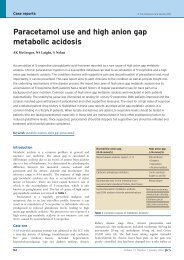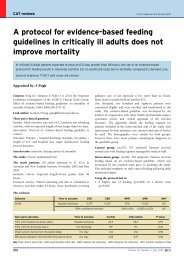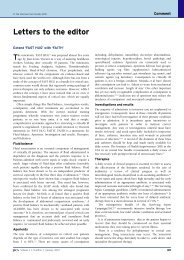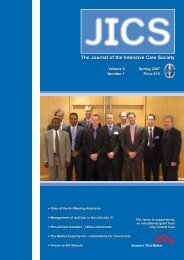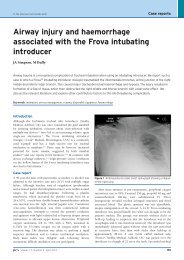Setting PEEP in ALI/ARDS - JICS - The Intensive Care Society
Setting PEEP in ALI/ARDS - JICS - The Intensive Care Society
Setting PEEP in ALI/ARDS - JICS - The Intensive Care Society
Create successful ePaper yourself
Turn your PDF publications into a flip-book with our unique Google optimized e-Paper software.
CAT reviews © <strong>The</strong> <strong>Intensive</strong> <strong>Care</strong> <strong>Society</strong> 2008<br />
<strong>Sett<strong>in</strong>g</strong> <strong>PEEP</strong> <strong>in</strong> <strong>ALI</strong>/<strong>ARDS</strong><br />
Compared to a low tidal volume/low <strong>PEEP</strong> strategy, a low tidal volume/fixed plateau pressure/higher <strong>PEEP</strong> strategy<br />
offers no mortality benefit but may be associated with reduced morbidity.<br />
Level of evidence: 1 + (RCT with a low risk of bias)<br />
Appraised by: SC Griffiths, C Cairns<br />
Citation: Mercat A, Richard JM, Vielle B et al. Positive endexpiratory<br />
pressure sett<strong>in</strong>g <strong>in</strong> adults with acute lung <strong>in</strong>jury and<br />
acute respiratory distress syndrome: a randomized controlled<br />
trial. JAMA 2008; 299: 646-55.<br />
Lead author: Ala<strong>in</strong> Mercat<br />
Three-part cl<strong>in</strong>ical question:<br />
Patients: Adults receiv<strong>in</strong>g mechanical ventilation for<br />
hypoxaemic respiratory failure caused by acute lung <strong>in</strong>jury<br />
(<strong>ALI</strong>) or acute respiratory distress syndrome (<strong>ARDS</strong>).<br />
Intervention: Comparison of a m<strong>in</strong>imal distension strategy ie<br />
moderate <strong>PEEP</strong> (5-9 cm H 2 O) aga<strong>in</strong>st an <strong>in</strong>creased recruitment<br />
strategy, ie level of <strong>PEEP</strong> set to reach a plateau pressure of 28 to<br />
30 cm H 2 O. Tidal volume (Vt) of 6 mL/kg used <strong>in</strong> both groups.<br />
Outcomes: Primary – 28-day mortality; Secondary – 60-day<br />
mortality, ventilator-free days, organ failure-free days at 28<br />
days, <strong>in</strong>cidence of pneumothorax dur<strong>in</strong>g treatment.<br />
Search terms: <strong>ARDS</strong>; <strong>ALI</strong>; <strong>PEEP</strong>; ventilation; RCT; mortality<br />
<strong>The</strong> study: Multi-centre, s<strong>in</strong>gle-bl<strong>in</strong>ded, concealed randomised<br />
controlled trial with <strong>in</strong>tention-to-treat analysis.<br />
Study patients: From 37 ICUs <strong>in</strong> France over a three-year<br />
period. Age >18 years.<br />
Exclusions: Pneumothorax, do-not-resuscitate order, chronic<br />
liver failure, lack of consent, expected duration of ventilation<br />
CAT reviews<br />
Sub-group analysis: In patients with <strong>ARDS</strong>, the <strong>in</strong>creased<br />
distension protocol was associated with earlier extubation and<br />
a trend towards improved mortality. <strong>The</strong> opposite was observed<br />
with patients with <strong>ALI</strong> but not <strong>ARDS</strong>.<br />
EBM questions:<br />
1. Do the methods allow adequate test<strong>in</strong>g of the hypothesis? Yes.<br />
However, the study is potentially underpowered. <strong>The</strong> study<br />
was stopped early after the 18th scheduled <strong>in</strong>terim analysis<br />
by the monitor<strong>in</strong>g board, due to failure to demonstrate a<br />
10% absolute reduction <strong>in</strong> mortality. (Target recruitment<br />
was 400 patients <strong>in</strong> each arm assum<strong>in</strong>g 40% mortality <strong>in</strong><br />
the control group.) <strong>The</strong> sub-group analysis of <strong>ARDS</strong> vs<br />
non-<strong>ARDS</strong> <strong>ALI</strong> relies on very small patient numbers.<br />
2. Do the statistical tests correctly test the results to allow<br />
differentiation of statistically significant results? Yes.<br />
3. Are the conclusions valid <strong>in</strong> light of results? Perhaps. <strong>The</strong><br />
distension protocol was associated with less ventilation<br />
time and less need for adjunctive therapies.<br />
4. Did results get omitted and why? Yes. One patient was lost to<br />
follow-up. However, this patient was <strong>in</strong>cluded <strong>in</strong> the<br />
<strong>in</strong>tention-to-treat analysis.<br />
5. Did they suggest areas of further research? Yes. <strong>The</strong>y<br />
suggested further studies to determ<strong>in</strong>e the ideal balance<br />
between lower plateau pressures and higher <strong>PEEP</strong>.<br />
6. Did they make recommendations and are these appropriate?<br />
<strong>The</strong> authors make no general recommendations about what<br />
level of <strong>PEEP</strong> to use. Based on subgroup analysis they do<br />
suggest a strategy of high level of <strong>PEEP</strong> and low tidal<br />
volume should be used <strong>in</strong> caution <strong>in</strong> <strong>ALI</strong>.<br />
7. Is this study relevant to my cl<strong>in</strong>ical practice? No. This study<br />
did look at similar patients with regard to age, sex and<br />
severity of illness as present to general ICUs <strong>in</strong> the UK.<br />
However, the study really used two non-standard<br />
ventilation strategies when consider<strong>in</strong>g current practice.<br />
One could argue that the gold standard for the control arm<br />
of any <strong>ARDS</strong> study should be the <strong>in</strong>terventional strategy<br />
used <strong>in</strong> the <strong>ARDS</strong>Net study.<br />
<strong>The</strong>re are two ma<strong>in</strong> concerns with the study protocol:<br />
• <strong>The</strong> m<strong>in</strong>imal distension group used significantly lower<br />
<strong>PEEP</strong> levels compared with conventional current<br />
ventilatory management.<br />
• <strong>The</strong> <strong>PEEP</strong> <strong>in</strong> the recruitment arm is really determ<strong>in</strong>ed by<br />
lung compliance, <strong>in</strong> that, once the <strong>in</strong>spiratory pressure has<br />
been set to achieve 6 mL/kg tidal volume, the rema<strong>in</strong>der of<br />
the 30 cm H 2 O plateau pressure will be used for <strong>PEEP</strong>. In<br />
relatively compliant lungs, this could lead to unnecessarily<br />
high <strong>PEEP</strong> levels which could be detrimental. This may<br />
account for the trends towards poorer outcome <strong>in</strong> <strong>ALI</strong>-only<br />
patients and the greater need for fluid boli <strong>in</strong> this group. In<br />
other words many of these patients may not require such a<br />
plateau pressure.<br />
8. What level of evidence does this represent? 1 +<br />
9. What grade of recommendation can I make on this alone? B<br />
10. What grade of recommendation can I make when this study is<br />
considered along with other available evidence? No other<br />
studies compare these ventilation strategies. However, most<br />
recent studies agree that low tidal volume/plateau pressure<br />
strategies should be employed.<br />
11. Should I change my practice <strong>in</strong> light of this study? If you<br />
currently use <strong>ARDS</strong>Net ventilation strategies then there is<br />
little evidence here to change your practice.<br />
12. Should I audit my current practice because of these results?<br />
Yes.<br />
Appraised by:<br />
Sue Griffiths, SpR Anaesthetics, Royal Liverpool University<br />
Hospital. suegriff99@mac.com<br />
Chris Cairns, Consultant, <strong>Intensive</strong> care, Stirl<strong>in</strong>g Royal<br />
Infirmary. Chris.Cairns2@nhs.net<br />
<strong>JICS</strong> Volume 9, Number 3, October 2008 267


